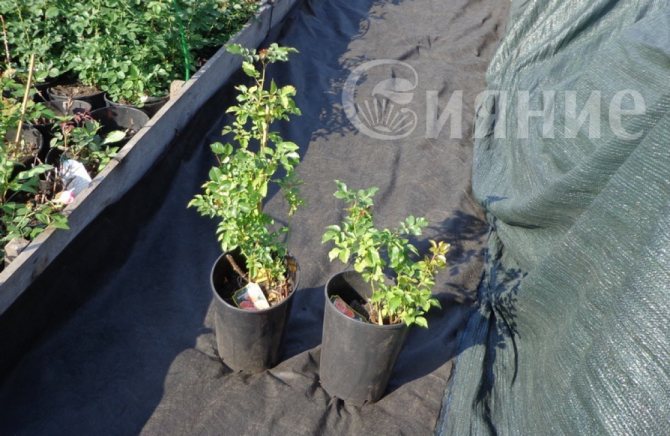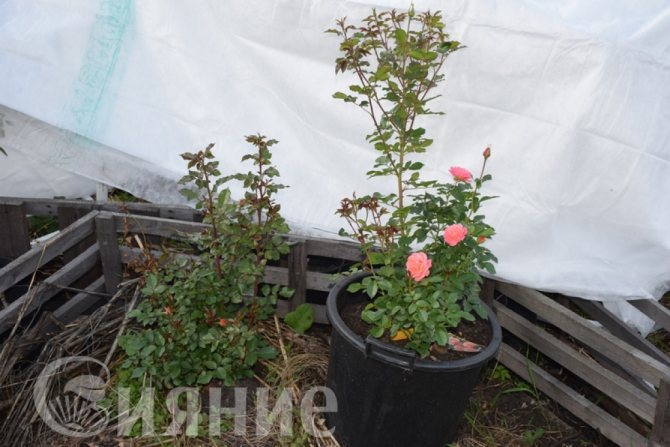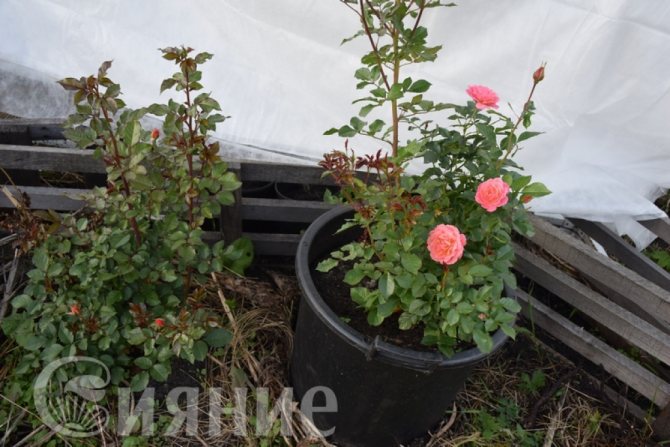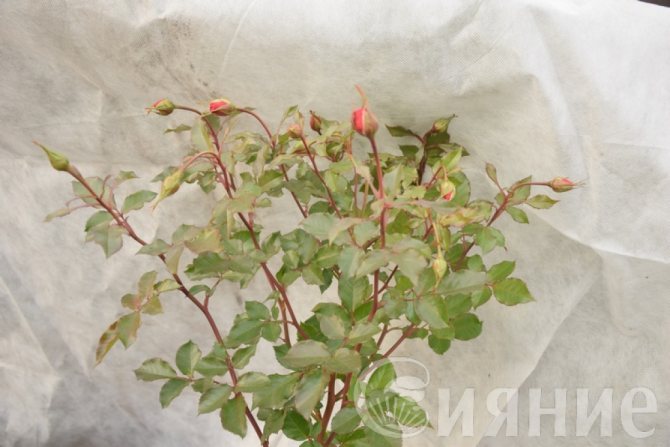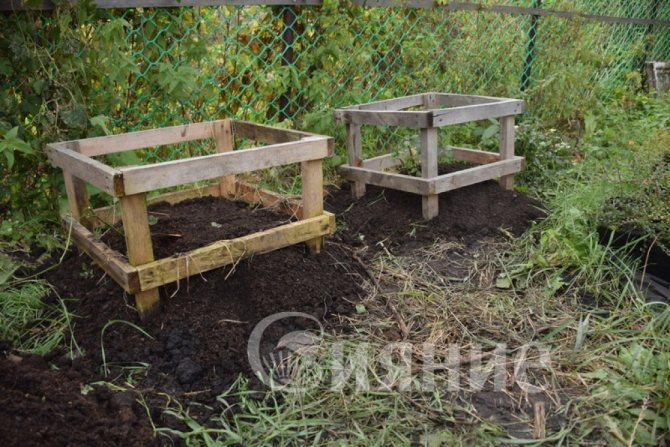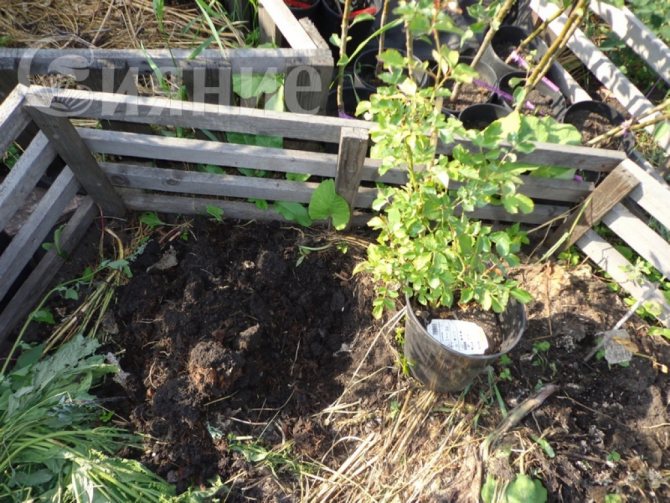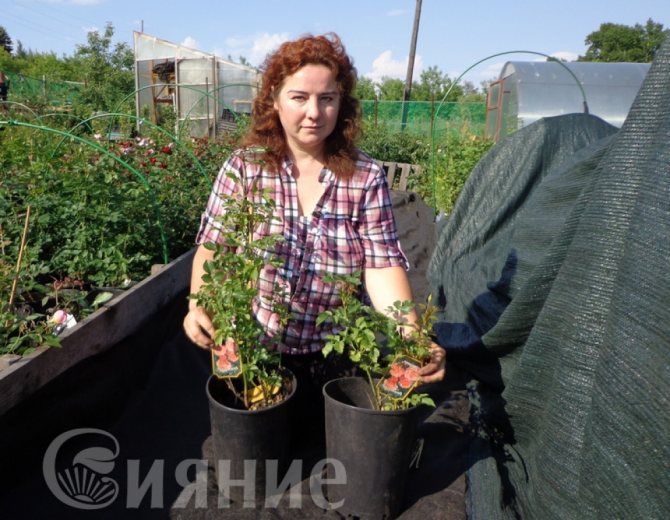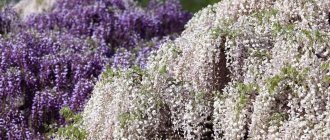The best varieties of roses for Siberia
This review presents the most hardy, frost-resistant varieties adapted to the climatic and soil conditions of Siberia. These plants are distinguished by strong immunity to major diseases and pests., do not lose their decorative effect during heavy rainfall.
Chippendale
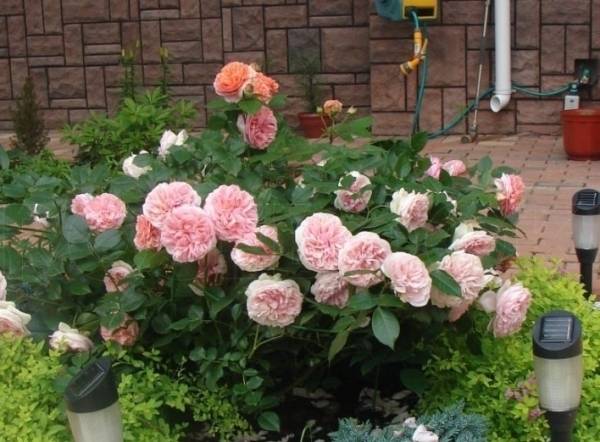
Roses Chippendale
A plant that forms a bush 80-120 cm high and 100 cm wide. Terry flowers in the old style, bright orange with a diameter of 10-12 cm... Recommended for planting in massive flower beds, as an accent in the background.
Queen Elizabeth
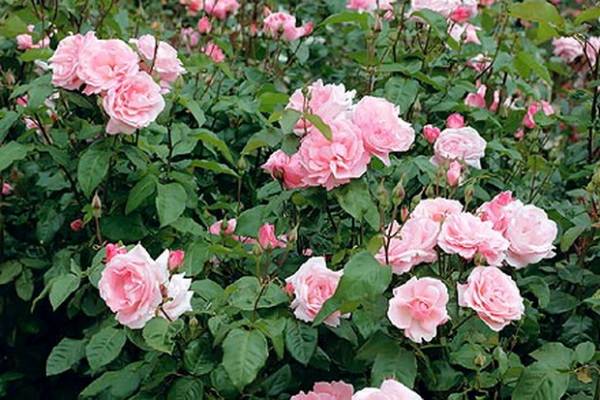

Roses Queen Elizabeth
The bush is from 100 to 250 cm high. The flowers are double, goblet, pink, 10 cm in diameter. The plant forms a compact shrub suitable for planting in confined spaces... It grows well on poor soils.
Golden Celebration
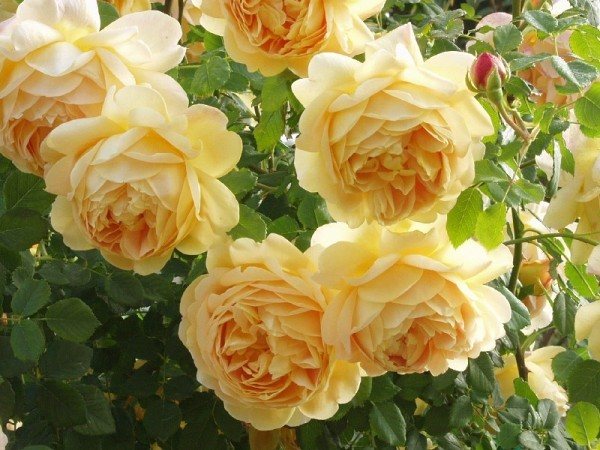

Roses Golden Celebration
A rounded bush with a height of 120-150 cm and a width of 120 cm. The flowers combine an old shape and an unusual copper-yellow color, differ in large sizes from 14 to 16 cm in diameter. Features of the variety - rapid growth of shoots, spicy-fruity aroma of flowers... Flowers do not open during heavy rains. An excellent option for decorating mixborders.
William Shakespeare 2000
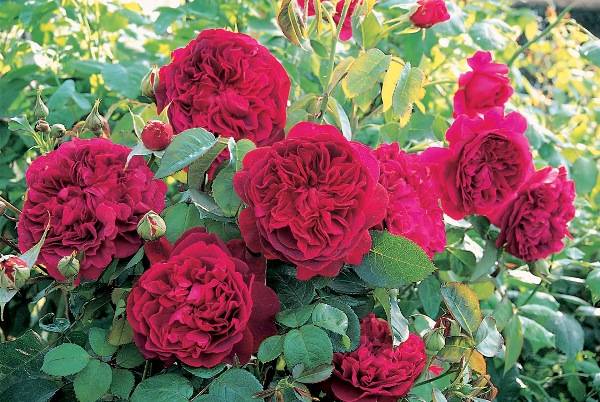

Roses William Shakespeare 2000
The variety is considered to be the best among red roses. The plant forms a lush bush 100-120 cm high and 100 cm wide... Differs in the rapid flowering of new shoots, the formation of large brushes that stay on the bush for more than 2 weeks. The flowers are densely double, bright purple, more than 10 cm in diameter with a characteristic aroma. Suitable for single and group plantings.
New Dawn
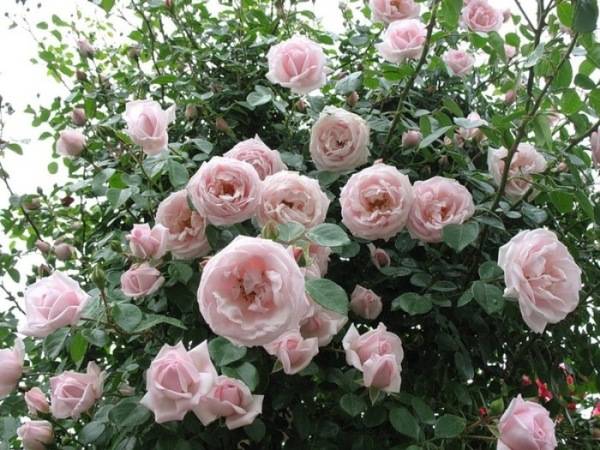

Roses New Dawn
A climbing plant that, with a support, reaches up to 5 m in height, and without it up to 2 m. The variety is distinguished by continuous flowering from June to late autumn.... The flowers are pastel pink, 7-8 cm in diameter. The bush opens up most vividly when planted near a tree during free hanging of the lashes from the branches.
Westerland


Roses of Westerland
The variety is distinguished by its high (2 m) and wide bush (1.5 m). Terry flowers 10-11 cm in diameter with a pronounced aroma... They change color during the season: orange, apricot shades smoothly turn into pink. The plant can be used as a climbing and bushy plant. The variety is self-sufficient for single plantings.
Rosarium Uetersen


Rosarium Uetersen roses
Lush shrub 200-350 cm high and 200 cm wide. Flowers 9-12 cm in diameter, densely double, saturated pink shade with a light aroma... Suitable for decorating spacious lawns.
Preparing a rose for shelter
Before sheltering, you should not only cut the roses, but also remove the green leaves remaining on the shoots. The main thing is to remove the leaves carefully, trying not to damage the bud on the shoot.
Leaves should be removed in order to avoid infections - if the leaf first freezes and then thaws and starts to rot during a thaw, this will not do anything good for a covered rose. In addition, fungus is quite common on the leaves of a rose. This is also a completely unnecessary neighborhood for a wintering rose.
The leaves remaining on the shoots should be removed just before you are going to cover your rose. If you do this earlier, new leaves will begin to appear on the shoots.
From the beginning of September, you should stop loosening the soil under the rose bushes, and from about the middle of this month you need to stop watering. Rose begins to prepare for winter.In dry, cool soil, the roots will feel better.
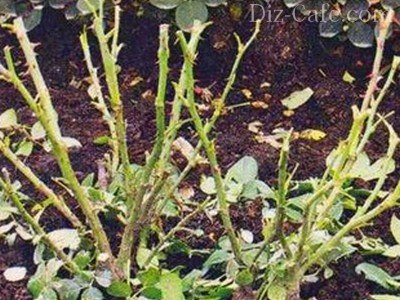

What roses should you choose for Siberia?
The peculiarities of the Siberian climate are late spring, a small number of warm days, severe winters, hard Siberian frosts. Such conditions can only withstand plants zoned in the regional climate. therefore the first rule for gardeners is to purchase a seedling from local nurseries.
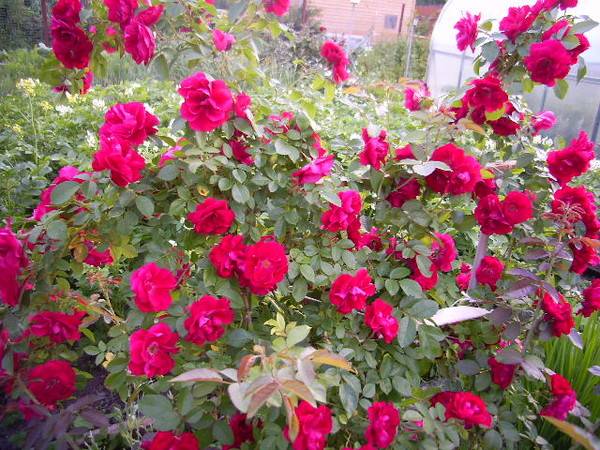

The basis for breeding frost-resistant varieties of roses for Siberia is Canadian and some hybrid varieties.
It is much easier to take root and are distinguished by their endurance of roses grafted onto a dog rose. It is distinguished by strong immunity to diseases, the ability to adapt to any conditions and quickly recover from cold damage.
The scion should also have a good characteristic. The best indicators in all parameters are shown by the varieties of Canadian selection., derived taking into account the climate of this country, similar to the conditions of Siberia. Roses for planting in Siberia must have high frost resistance, disease and pest resistance.
Winter-hardy varieties for the Siberian region
The most hardy are the varieties of roses grafted onto rose hips. And the characteristics of the scions meet rather stringent requirements. However, due to the abundance of varieties on the market, it is difficult to decide which roses are the most unpretentious and winter-hardy for Siberia. They are protected from diseases by good immunity, and after damage by unexpected frosts, they are able to recover in a short time without much loss.
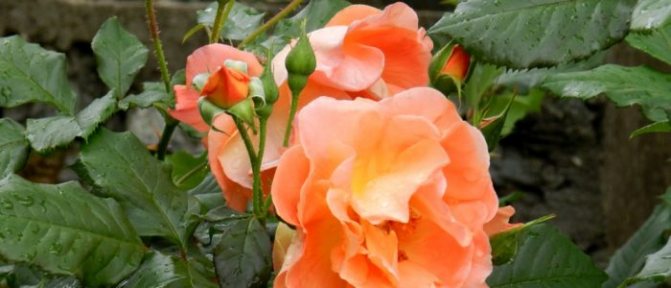

Rose "Westerland"
Winter hardiness of plants largely depends on:
- from correct and timely preparation for the cold season;
- arrangement of reliable shelters;
- regular use of fertilizers and dressings.
Growing and breeding roses in the Siberian region requires from gardeners not only great efforts, but also attention to the needs of a single plant. The best frost-resistant roses for Siberia:
- Chippendale is a vigorous scrub with salmon pink flowers.
- New Dawn - Sometimes classified as curly (rambler). Suitable for poor soils, grows in partial shade, high, shoot length up to 2 m.
- Golden Celebration is growing rapidly. Flowers are copper-yellow, densely double, 12-14 cm in size.
- Westerland - can be grown in bush or climbing form. The flowers are orange with a hint of apricot, golden and pink. The bush is wide (up to 1.5 m).
- Rosarium Uthersen - shaped like a climber or scrub. Huge pink flowers are collected in a brush. Plant height reaches 3.5 m.
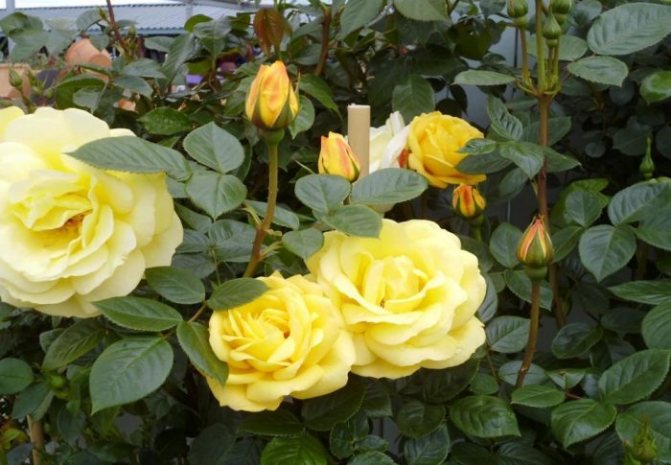

Roses "Arthur Bell"
The best varieties of floribunda roses for Siberia are Arthur Bell (looks great in group plantings), Deja Vu (flowers are suitable for cutting), Sunsprite (high frost resistance, resistance against most diseases, grows on poor soils).
Important! The first two years are difficult for adaptation, over time the bushes become more cold-resistant, their resistance to difficult weather conditions increases.
The seeds of the Siberian rose Kalistegia are also quite in demand. This vine blooms in the first year after planting. Calistegia's buds appear in each leaf axil.
Features of planting roses
Since spring is late in Siberia, the soil often does not have time to warm up to a comfortable temperature for the roots, it is recommended to plant them on the southern side of the site. To prevent bud burnout, it is advisable that the plants are in the shade during the hours of the very activity of the sun.
The climate of Siberia is characterized by cold north and west winds. Therefore, the rosary must have protection from these directions. These can be walls of buildings, bushy plants, gazebos or hedges. So that the barrier from the wind does not greatly shade the roses, they are planted at some distance.
For the rose garden, if possible, select elevated areas... In such places, the soil does not have time to freeze to critical temperatures and quickly thaws.This means that the roots will develop faster in the spring, less risk of rotting due to excessive moisture.


The planting season of roses in Siberia begins in May, when the soil warms up to 10 degrees.
In Siberia, roses are recommended to be planted in spring. Event are planned from May 15 to June 15... In this case, the air temperature should not be lower than + 10 ° С. The shoots of plants planted later than these dates do not have time to ripen, which becomes the cause of death in the very first winter season.
The rest of the planting of roses in Siberia differs little from warmer regions. A planting pit (50x50x50x) is formed on a pre-dug area for plants and the substrate is prepared. To do this, mix the components on a piece of film:
- humus 3 parts;
- peat 2 parts;
- weathered clay 1 part;
- river sand 1 part;
- wood ash 400 g.
The minerals superphosphate 300 g and potassium sulfate 30 g are added to the soil mixture.
During planting, a hill is formed at the bottom of the pit, on which a seedling is placed and the roots are spread. After dusting the roots and compaction of the trunk circle, pour 10 liters of warm water... After that, the bush is spud to a height of 10-15 cm, the soil under the bush is mulched with peat or humus. At first after planting, the seedlings should be protected from direct sunlight.
Choosing a location: looking for the sunny side
Due to the fact that spring comes late in Siberia, and there are not very many sunny days in the year, they try to plant roses from the south. But a completely open area is not very profitable, since the flowering period is significantly accelerated, and the flowers fade in the heat. It is best to think over a light partial shade with the help of light-leaved shrubs or trees. The roses are planted near them so that in the hottest time of the day they are protected by the foliage of the "neighbors".
It is advisable to select high places of the site for the rose garden. There, the degree of soil freezing is always less, which means that the roots will wake up faster. This will save the plant from high humidity, which is typical for lowlands. Too much moisture provokes the development of rot and fungal infections.
Recent Entries
Rose Petal Jam and Its 7 Health Benefits You Likely Didn't Know About What Fruit Are You According to the Zodiac Sign 11 Best Grape Varieties That Will Help You Create Unique Homemade Wine
Strong winds are not uncommon in Siberia, with a cold front coming from both the north and the west. From these directions (north, north-west and north-east) roses need protection in the form of buildings, gazebos, living coniferous hedges, etc. But the wall should be at such a distance that no shadow is cast on the bushes.
The material on plants suitable for hedges will also be useful:
Siberian rose care basics
The roots of roses penetrate deep enough. Therefore, the plants do not need frequent watering. It is enough to carry out it once every 3-5 days, depending on the weather.... In this case, the earthen lump should be completely wetted, the rate is determined by the size of the bush from 10 to 20 liters.
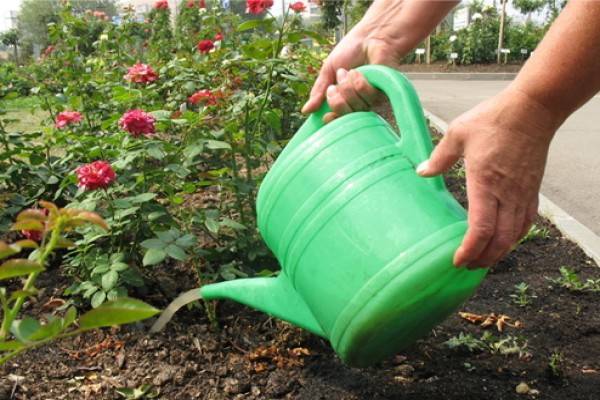

Stop watering roses in mid-August
In the first year after planting, the plants do not need feeding. In subsequent seasons, it is important to feed the roses regularly.:
- in early spring: an aqueous solution of ammonium nitrate (20 g / 10 l);
- after 15 days repeated fertilization with ammonium nitrate, watering with mullein infusion (1: 10), 4 liters for each bush;
- at the beginning of budding calcium nitrate solution (1 tbsp. l / 10 l);
- a week after that are useful foliar feeding: solutions of double superphosphate, potassium nitrate, mullein or ash infusions, macronutrients to choose from;
- before flowering solutions of potassium magnesium or potassium humate;
- after flowering and sanitary pruning mineral complexes with an increased content of potassium and phosphorus (1 tbsp. l / 10 l);
- at the beginning of August organic solution, after 2 weeks with potassium-phosphorus complexes, and after another week with potassium sulfate.
- in September potassium magnesium.
The rest is seasonal maintenance consists of regular weeding and loosening of the trunk circle, shaping and sanitary pruning... To prevent diseases in spring and autumn, the bushes are sprayed with fungicidal solutions.


Spring pruning of a rose grown in the Siberian region is carried out after the ground has completely thawed (in May)
To stimulate the ripening of shoots, watering is stopped since August. In the third decade of September, in dry weather, water-charging irrigation is carried out. Water norm for one bush 40-50 l... Soil moistened in deep layers freezes and thaws more slowly, retains heat longer.
During this period, the loosening of the trunk circle and the forming pruning are stopped. This is necessary to prevent the growth of new shoots.
Until the cold weather is below 0 ° C, the shoots of the rose are tied with twine and bent to the ground... It is important to avoid the contact of the branches with the soil, which leads to rotting of the stems, so they are fixed with a wire hook.


Cover roses as close as possible to the onset of frost to prevent debate processes
On top of the prepared shrub, wooden shields in the form of a roof are installed, securing them with pegs. The ends should be closed only after the temperature has been set below -7 ° C.... A dense plastic wrap is laid on top of the shelter and fixed.
Despite the whimsicality of plants, gardeners admit that cultivation of roses in Siberia allows you to create a special atmosphere in your personal plot... Only the first 2 years are considered particularly difficult. As they grow older, properly cared for roses, they become much more resilient and do not require close attention.
Ways to hide roses for the winter in Siberia
The main requirement that the shelter of a rose (and any other perennial plant) must meet is that it must be dry inside and the same temperature must be maintained. A sharp change in temperature inside the shelter leads to the formation of condensation and an increase in humidity, which has a detrimental effect on the rose: the bark begins to get wet, flake off. Mold appears on the plant, rot develops.
In most of Siberia, winters, albeit frosty, are snowy. Snow is an excellent insulation, a 40 cm layer of snow is enough to reliably insulate the plant. But, you should not rely only on snow. In the shelter of roses, various materials are used: film, agrofibre, spruce branches, sawdust, slate.
Important! So that mice do not start under cover and do not damage the roses, you need to take care of deterrents. Rodents do not like the smell of ichthyol, Vishnevsky's ointment, wormwood, tansy, pine smell.
Air dry method
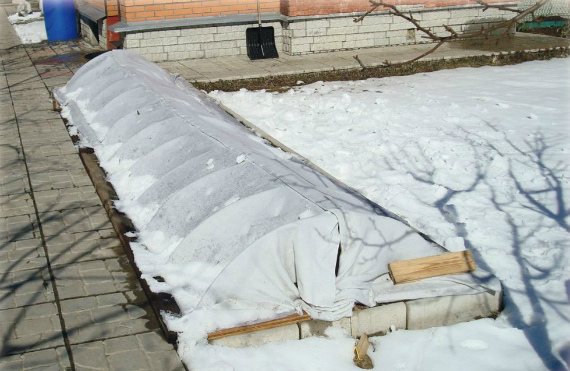

The method is based on creating an air gap between the plant and the layer of snow that has fallen out. Air + snow can protect the rose from frost down to -30 degrees.
A rose bush, processed as described above, is bent or mulched with dry earth to a height of 30 cm. Strong metal arcs are installed above the plant or lattice boxes are constructed from strong slats, bars. The distance between the plant and the walls and ceiling of the box must be at least 20 cm.
Any breathable material is thrown on top of the arches or box: lutrasil, agrospan, spanboard. The thickness of the material must be at least 60 g per meter. Some people use darnit, burlap. The fabric is secured to prevent it from being blown away by the wind.
The shelter is ready. Now, after a snowfall, it is advisable to paddle loose snow to the bushes so that a mound forms.
Hilling
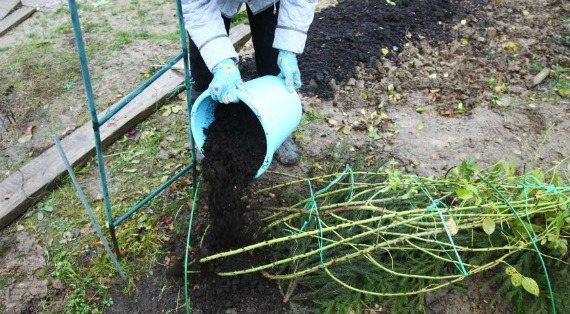

Some growers practice full hilling of roses, that is, they cover the whole plant with soil. The method is working, provided that the roses are planted in an elevated area with dry, sandy soil.
The bush is bent down, as usual, and covered with dry earth "headlong".From above, the layer of earth should be at least 20 cm. From above, the resulting mound is covered with a piece of plastic wrap so that during the melting of the snow moisture does not penetrate inside, to the rose.
Advice... For better looseness, you can mix the earth with sawdust in a ratio of 1 to 1. It would be wrong to rake the earth right there, around the roses. The roots of the plant lie close to the surface, and a decrease in the soil layer above them leads to freezing in winter. The soil for hilling is brought from another place.
The disadvantage of this method is the difficulty of digging a rose in the spring. The soil thaws gradually, respectively, and the rose will have to be dug out in several passes. This is done very carefully so as not to damage the kidneys and bark.
Advice... If you wrap a rose bush with lutrasil before hilling, it will be easier to free it from the soil in the spring.
Shelter with spruce branches


If the gardener has a large amount of spruce branches, then the question "how to cover the roses" is not worth it. Spruce branches with needles are used both as a substrate for shoots and as a cover for spray roses from above.
Attention! The spruce aroma repels pests - rodents.
The spruce branches are laid on the roses so that a mound is formed, 40 cm high. The needles on the spruce branches will not allow the spruce branches to thicken, and air will circulate inside the shelter. From above, the structure is covered with agrofibre or film.
Car tires
A reliable "home for roses" can be built from tires of a suitable diameter. A cover is put on the bush from above, one or two more on it, depending on the height of the rose.
The entire space inside is filled with dry wood chips, foam chips or left empty. From above, the structure is covered with a piece of film, which is fixed with staples or pebbles.
Straw bags
Ordinary large bags, in which sugar and flour are sold, are loosely stuffed with straw or fallen leaves, sawdust. The resulting "pillows" are covered with rose bushes. From above, the shelter is completed with a cloth of agrofibre.
Houses made of boards, polycarbonate or slate
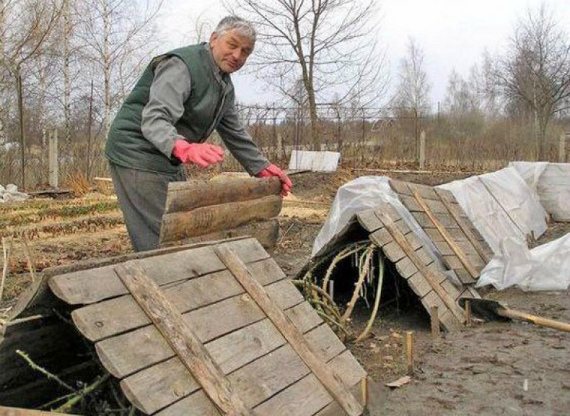

If there are building materials left on the farm from the construction of a house, greenhouse or utility block, they can be adapted for warming rose bushes.
Above each bush or group of plants, a simple shelter in the form of a hut or a shelter in the form of the letter "P" is installed. It is important to make the house strong so that it does not break under the weight of snow in winter and does not crush fragile roses. Pieces of walls are fastened with nails, wire, and not just leaned against each other.
The ends of the house remain open until stable cold weather sets in. When the deadline comes, the hut is covered with a thick film or spunboard on top.
Lutrasil
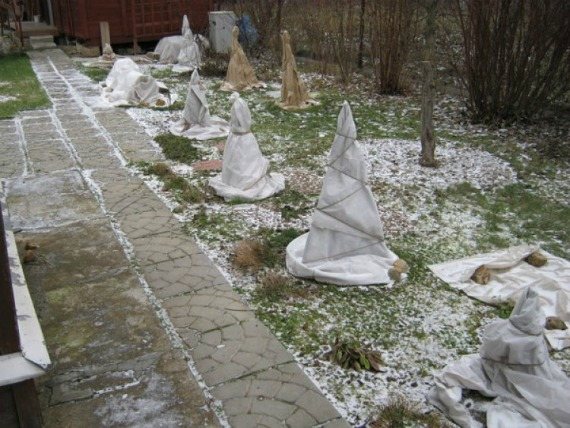

Modern covering materials effectively protect roses from the cold. Most importantly, they allow air to circulate, and condensation does not form inside the shelter. Therefore, when using breathable nonwoven fabric, it is not necessary to wait for cold weather. You can cover the rose garden immediately after processing the plants.
It is better to use the densest material options (more than 60 g per m2). Roses are covered in several layers. First, the above-ground part is wrapped in several turns with lutrasil or any of the insulation materials, then a couple more layers of material are put on top.
Advice... To prevent a snowdrift from breaking the branches of a rose bush in winter, it is better to throw lutrasil on top of metal arcs. It is enough to install 2 arcs on one bush, placing them crosswise.
Types of roses for growing in harsh climatic conditions with photos
For amateur flower growers living in a harsh climate with frosty and often snowless winters, it is quite difficult to preserve roses during cold weather. Initially, the rose was intended for growing in warm regions.But there were more and more people wishing to admire the beauty of this flower all over the world, and then the breeders set themselves the task of growing frost-resistant varieties that can survive fairly severe frosts. As a result of their work, the arsenal of flower growers was replenished with several types of roses, which are able to get along in unpredictable weather conditions not only in the middle zone, but also during severe pestilences in Siberia.
All types of winter-hardy roses are divided into three types:
- Absolutely frost resistant... They are able to winter in an upright position and even in severe frosts, which do not require attention.
- Medium winter hardy. They hibernate without shelter only in regions with a mild climate, but subject to sufficient snow cover. With a lack of snow, they can freeze. It is recommended to bend down the stems of the roses for a quality snow shelter.
- Relatively winter hardy. They overwinter in an upright position, subject to mild frosts. In regions with a harsh climate, they require high-quality, air-dry shelter.
Roses of Canadian selection
This species was bred in northern Canada, therefore it is resistant to the most severe frosts. Bushes, with proper cover, can withstand frosts down to -45... Canadian breeders began to breed winter-hardy roses in the second half of the 20th century. The work was funded by the state.
The assortment of the species is presented in two series: Explorer and Parkland. In 2009, another series appeared on the world market - Canadian Artists. Roses are intended for cultivation in 4 climatic zones. Therefore, under an earthen shelter they can winter in the conditions of Penza and St. Petersburg., as well as in all nearby cities. In the third climatic zone, in the conditions of the Urals and the Trans-Urals, for these roses it is necessary to build a frame shelter and cover them with spruce branches.
The most popular varieties of roses of this type:
- Charles Austin... The variety is ideal for the climate of the Moscow region. The height of the bush is up to one and a half meters. The flowers are orange, the color on the petals is paler than in the center.
- Morden centennial... Park rose with red-pinks. Medium sized flowers. The bush is high, sometimes it grows up to two meters.
- Wasagaming... Pink flowers with a pleasant, persistent scent. Unpretentious variety, withstands severe frost. According to gardeners' reviews, this variety is suitable even for the harsh climate of Tyumen..
Climbing roses
One of the clear advantages of this type of rose is its incredible resistance to temperature extremes. In summer cottages, this type is often used to decorate unattractive areas, decorate gazebos and fences. Shoots of climbing roses grow from two to 10-15 meters long and during flowering the bushes are completely covered with flowers. The varieties of small-flowered climbing roses are frost-resistant:
- Super Excelsa... It blooms in large fuchsia brushes. The bushes can easily endure heat and frost.
- Snow goose... The flowers of this variety resemble white balls. Thanks to the abundance of petals. Each cluster forms from 5 to 25 flowers. The variety blooms almost continuously for two months.
- Super dorothy... It has a particularly pleasant, strong aroma. The stems grow up to 3 meters. Flowers are semi-double, crimson.
- Rambling Rector... Chameleon variety: at the beginning of flowering are ivory. As they burn out in the sun, they become snow-white. Each cluster forms from 20 to 50 small flowers. The rose is capable of hibernating without shelter.
Ground cover roses
This type of roses is distinguished by its particular unpretentiousness and amazing vitality. They grow rapidly, forming a low, abundantly flowering bush with a diameter of up to three meters. They hibernate under the shelter of spruce branches and non-woven material, and in the conditions of the Volga region they are able to hibernate under a small layer of peat-soil mixture. The most popular varieties of roses:
- Amber Sun... The flowers have an unusual color, changing during flowering, at the beginning of blooming, the bud is copper-yellow, closer to wilting, it brightens to pale cream.
- Stadt Rum... The height of the bush is no more than 50 centimeters. It blooms with salmon. Does not fade or fade even in strong sun.
- Solero... The variety is highly resistant to diseases and pests. Flowers are bright yellow or lemon, cupped.
- Resident... A unique variety with increased resistance to rain. Recommended for growing in high humidity conditions in St. Petersburg. It blooms in semi-double flowers, collected in carpal inflorescences. The color of the petals is carmine, the middle of the flower is light pink.
- Golden Showers... The most winter-hardy variety of climbing roses. It blooms in bright yellow from June to late autumn. The variety is not picky about the composition of the soil and is resistant to diseases.
Floribunda roses
Floribunda species obtained as a result of crossing a hybrid tea and a polyanthus rose... Floribunda inherited abundant flowering, resistance to diseases and pests, and excellent winter hardiness from their progenitors. In the presence of an air-dry frame shelter, this species can tolerate frosts in minus 35-40 degrees. In regions with a milder climate, for example, in particular, in the gardens of Volgograd, floribunda can winter under a light peat-soil cover. The most frost-resistant are the following varieties of roses:
- Arthur Bell. The variety is especially popular in Europe, but it is quite suitable for growing in the vastness of Siberia and the middle zone. The height of the bush is 75-80 centimeters. The buds are semi-double, pale yellow in color with pink edging of the petals. Blooms in brushes of 3-5 pieces. Has a slight fruity aroma. The disadvantage of this variety is that the petals burn out in the sun.
- Deja vu... The variety was bred in Siberia and is characterized by increased winter hardiness. The bush is upright. With branches. The flowers are bright yellow with a coral edging of petals, cone-shaped.
- Jack Frost... The color of the buds is white with a slight green tint. The bud is goblet. When unfolded, the diameter of the flower is about 9 centimeters.
- Luminion... Blooms in inflorescences of 6-7 pieces. The flowers are cupped, fiery scarlet.
- Sunsprite (Freesia). It is considered the best representative of the floribunda species. Withstands frosts down to minus 30 degrees under light cover. Disease resistant. The flowers are cupped, golden in color. The disadvantage of the variety is the rapid shedding of the petals.
- Evelyn Fison... Sprawling bush, up to 80 centimeters in height. The flowers are cupped, bright red in the center, burgundy around the edges. The variety is resistant to sun and rain.
Shrub roses
Shrub roses or shrubs were bred in the middle of the last century. The words "shrub" in translation from English means "bush". In principle, all genera are shrubs. But shrubs are "bushes of bushes". Their height often reaches 2 meters, the stems are powerful, resilient.
Shrabs are frost-resistant. In the middle lane, they can winter without shelter, in regions with severe frosts, they require only light shelters. It is customary to refer to scrubs as many subgroups. Basically, this group includes varieties that are not ideally suited to other species. The most frost-resistant varieties are:
- Crown Princess Margaret. The height of the bush is 2.5 meters. Abundant bloom from June to October. Apricot flowers, rich shade. Has a strong fruity aroma.
- Snow ballet. The flowers are white. Up to 7 centimeters in diameter, with a delicate aroma.
- Gazebo. Resistant to drought, frost, disease, rain and burnout. Flowers up to 12 centimeters in diameter, golden pink. Long flowering.
- Manstead Wood. The color of the flowers is burgundy or red, crimson at the beginning of flowering. The bush is dense, large in diameter, up to one and a half meters high.
- Lilac rain... A variety with increased frost resistance, does not freeze even in the absence of snow. It blooms with lilac flowers. Flowers are small in size, densely double. Wavy flowering, repeated. The height of the bush is 60-120 centimeters.
- Abraham Derby. Pink-apricot flowers, richer in the center and lighter at the edges. The diameter of the flower is about 14-15 centimeters. 2-3 flowers are formed on one stem.The bush is 130-140 centimeters high.
- Piano. Flowers are spherical at the bud stage and cupped, densely doubled when opened. Depending on the variety, the flowers range from pale cream to burgundy. The diameter of the flower is about 12 centimeters. The flowering is undulating. The height of the bush is 120-130 centimeters, the width is no more than 60 centimeters. It tolerates frost well, but is not resistant to rain.
- Toscanini. One of the most frost-resistant varieties, it can winter without shelter even during severe frosts. It blooms in red, the diameter of the flower is about 10 centimeters. With strong pruning, it can hibernate without shelter. The height of the bush is 130 centimeters. The stems are of uneven length, which gives the bush a somewhat unkempt appearance.
We invite you to get acquainted with the features of growing garden roses. Happy viewing!
When amateur flower growers begin to remove shelters from roses in the spring, all these blankets made of agrotextiles and spruce branches, they involuntarily think about how to grow non-sheltering frost-resistant varieties so that they can grow in the garden without any hassle, like tulips. There is an example of this. Lyubov Bezrodnova, who lives in the Vladimir region, for 10 years has brought out on her garden plot a whole collection of park roses that are resistant to low temperatures. For the winter, they do not need to be cut off or covered. Now in this collection there are about 400 varieties of roses, suitable for growing in the climatic conditions of the Urals and Siberia.
It all started with the fact that Lyubov Bezrodnova, visiting flower exhibitions, was looking for the most frost-resistant varieties of roses. She also established contacts with flower growers in the northern regions of the country and bought mother material from them. On her site, she was engaged in their reproduction and grafting on frost-resistant rosehip varieties. Then she just planted her roses and left them for the winter without any shelter. They will survive two winters - good, but if not, they will be discarded.
Caring for non-covering frost-resistant roses is of course also important. In November, only flowers and buds should be cut from them. In no case should you shorten the stems - they can freeze to the very ground. And so 60% of all branches will be preserved. In the spring, those that are frozen are pruned, and new ones will grow and give flowers in due time.
Lyubov Bezrodnova manages to temper any park roses, even imported ones, and adapt them to our harsh climate. The correct fit is important here. This must be done so as not to damage the root system. All broken roots must be cut with pruning shears and be sure to remove existing flowers. In the first winter for the rose bush, it is necessary to create comfortable conditions, protecting it with a dry shelter. After a year, it will be enough just to huddle it up - let it get used to the frost. Park roses adapt well and can get used to the local climate in two seasons.
Open frost-resistant roses for the Urals and Siberia in the rose garden of Lyubov Bezrodnova are available for all tastes. There are not only park varieties, but also seasoned hybrid tea, floribunda, spray and climbing. Only the last of the entire Siberian collection require styling and shelter for the winter. The rest hibernate on their own.
www.fazenda-
How to cover climbing roses for the winter in Siberia
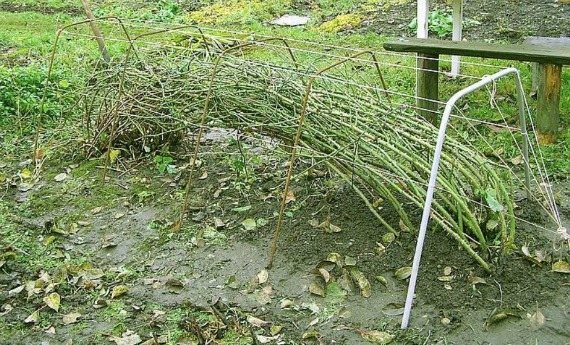

Long shoots of climbing rose require careful handling. They are removed from their supports, cut off and treated for diseases. When pruning, you should remove all unripe shoots and tops of branches, since they will not survive the winter anyway, and may rot. On each plant, only 7-8 strong healthy shoots are left, which next year will delight you with numerous buds.
It is convenient to roll the shoots of a climbing rose into a ring and tie it with twine in this position. The folded overhead part is placed not on bare ground, but on a sawdust pillow, a piece of Styrofoam or a board. The base of the stem must be sprinkled with sawdust or soil to a height of 30 cm.
From above, the rose is covered with shavings so that a mound is formed, 30-40 cm high. Cover the bush with non-woven material or film.
Another option for shelter is to build a hut above the rose made of bushes of plywood, slate, and a sheet of polycarbonate. The space inside the house is not filled with anything. The shelter is covered from above with lutrasil or film, after a snowfall, it is covered with snow.
Westerland (Westerland)
The homeland of this variety is Germany. But today these climbing roses feel great in Russia, including in Siberia, because many "sissy" roses can envy their resistance to frost.
Westerland is insensitive to powdery mildew and black spot. His shade tolerance is average.
The flowers are quite large (diameter can reach 12 cm), semi-double, wavy petals. Their color deserves special attention - a bright "cocktail" of orange, scarlet, pink and yellow shades is striking in its beauty. Color may vary slightly depending on weather conditions. The foliage is bright green.
General recommendations
Despite the fact that these varieties of roses can be called true "Spartans", still no plant will survive without shelter when the thermometer shows -20-30 ° C or lower temperature. Take care of winter shelter, even if the rose is very hardy.
There is a deficit of the sun in Siberia. Therefore, it is better to plant a climbing rose from the south, but not in an open area (in summer, the flowers can burn out in the sun, and in winter they can suffer from strong winds).
Now you know about the 5 best varieties of climbing roses for the Siberian region. Choose any, decorate your site with these luxurious plants. And you can enjoy their scent and luxurious flowers every summer without any unpleasant surprises!
Tags: rose, siberia, variety, floribund, good
About
«Previous post
William Shakespeare 2000 (William Shakespeare 2000)
The creator of this rose is English breeder David Austin, who called it the best English climbing rose of all time.
The plant not only gives luxurious flowers, but is also resistant to cold weather, is almost not susceptible to fungal diseases, and feels good in the shade. The ancestor of the variety - William Shakespeare - does not have such good resistance, so when buying you need to pay attention to the presence of a numerical complement - 2000.
Roses of this variety have double, beautifully decorated flowers of a rich crimson-red color, which gradually turns into lilac. The average diameter of the flowers is 9 cm. The leaves are matte, dark green.
Why you need to prune roses in the fall
Autumn pruning of roses is one of the most important procedures that must be applied to plants before winter shelter. First of all, pruning is necessary to strengthen the plant before the winter cold. Correctly cut in the fall, a rose can easily overwinter even in the harsh conditions of Siberia.
The basic rules for the autumn pruning of roses are reduced to the removal:
- old shoots (these are thick branches covered with lignified bark, which are three or more years old);
- shoots of white color, which cannot survive in winter conditions, and in spring they will become a source of infection for healthy shoots located next to them;
- the youngest, not fully formed shoots, which also will not survive the winter even in a shelter, and will begin to rot, spreading the infection;
- branches growing inside the bush and interfering with the development of other shoots;
- dry dying stems with dried flowers and leaves.
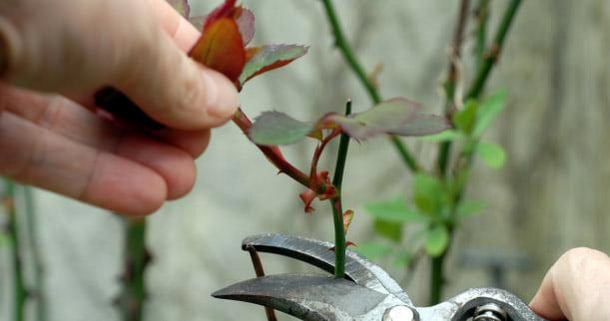

It should be remembered that in the fall you need to cut not only those roses that have long been growing on your site, but also roses planted in spring and recently rooted. Such young plants should also be shortened by removing flowers and unblown buds from the shoots.
This contributes to the quickest adaptation of the rose in the open field and, of course, successful wintering, which young plants tolerate worse than adult rose bushes.
Rosarium Uetersen
If we talk about winter-hardy varieties of roses, it is worth mentioning the most unpretentious roses, which are called Rosarium Uetersen. They are very beautiful and can be seen blooming during the three summer months. Bushes grow quietly in any place designated for them on the site.
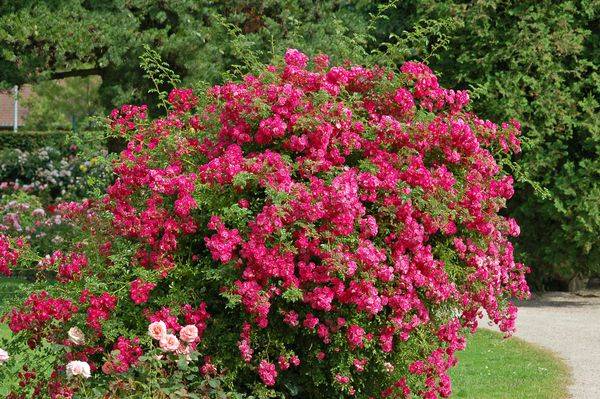

The culture belongs to the Climber group. Experienced gardeners often grow these frost-resistant flowers, the bushes of which can reach 3 meters in height, using the standard method. It is worth remembering such a feature of this most beautiful culture as a decrease in the size of inflorescences in the presence of too low air temperatures.
Features of preparing for winter different types of roses


Shelter of plants for the winter, after all the preparatory measures, is carried out at an air temperature equal to 5 degrees of cold.
Climbing
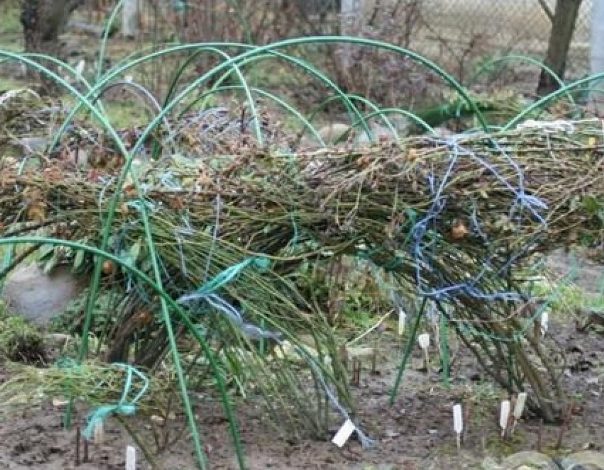

The land around the bushes is cleared of debris. Leaves break off the bushes. The branches of roses are removed from the supports, tied and treated with a fungicidal preparation. A sheet of roofing material, polystyrene or spruce branches is placed under the whip to protect the shoots from decay. A layer of sand or earth is poured on top.
Shoots bend over. With the onset of frost, the roses are covered with roofing material on top, the edges are fixed so that the shelter is not blown away by the wind.
A more reliable and time-consuming option for sheltering climbing roses for cold regions is the shield method. For it, 2 wooden or plywood boards are taken, up to 0.9 meters wide and equal to the length of the bush. The structure is installed on top of the fixed branches. Wedges are driven into the ground to secure the roof against displacement. A film is stretched on top or spruce branches are laid out.
You can also use the bushes tying method for shelter. In this case, the shoots are covered with spruce branches and spunbond. The shelter is pressed to the ground by boards, bricks and tarpaulins.
Floribunda


When preparing these roses, leaves are first cut from the bottom of the bushes. When pruning stems, 25-30 centimeters are removed from the total length. The lower part of the stems and the soil around the plants is treated with a 3% solution of copper sulfate or Bordeaux liquid. The ground around the bush is covered with a 15-centimeter layer of sand. The sand protects the roots from freezing.
Shoots are cut and treated with any pesticide. After that, they can be covered with any insulating materials, such as peat, compost, dry soil. High moor peat can be used for cover. The peat will keep the temperature constant and protect the bush from moisture. From above, the shelter is covered with specially prepared shields made of wood or spruce branches. Lapnik additionally protects bushes from rodents.
Hybrid tea
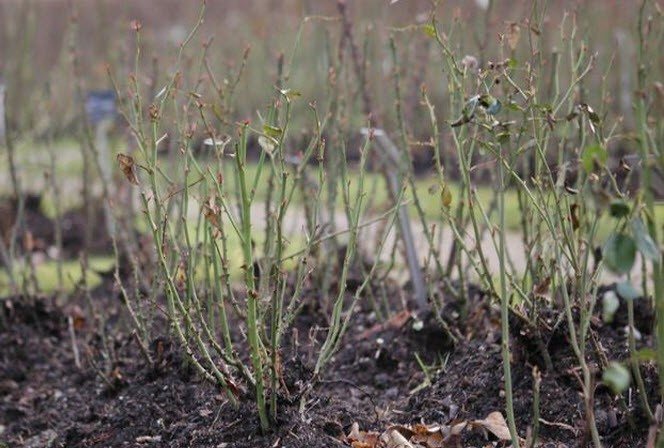

Hybrid tea varieties of roses require a gentle pruning of 10 centimeters. A protective frame is erected over the shortened shoots of roses when sheltered.
At the first frost, the remaining leaves and unripe stems are removed from the plants. Frames are formed from boards, plywood or boards. They are covered with agrofibre. The ends remain free. When frosty weather sets in, they close.
A film is spread on top of the covering material, which will protect the bushes from snow and moisture. The edges of the film are fixed from below with bricks or boards. This method of sheltering bushes is not used on too wet soils, since in this case moisture will collect inside the shelter, which will harm the plants.
Park
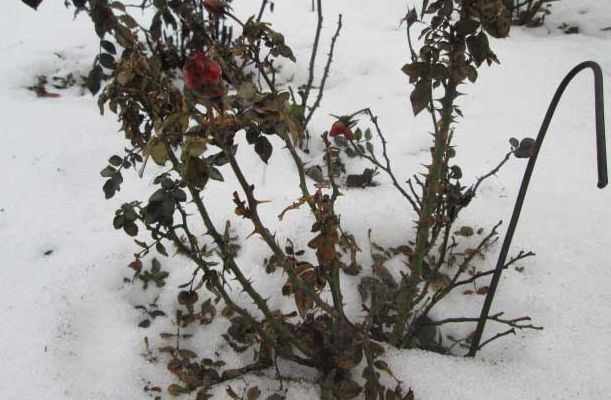

Frost-resistant park varieties are practically not pruned. Before wintering, for better flowering, all strong growths are shortened by 5-10 centimeters. In addition, damaged and dry stems are removed.
Before the onset of the first frost, the bushes are covered with peat or earth by 15-20 centimeters. The stems are bent to the ground. A frame of spruce branches or boards is formed on top, which is covered with a layer of kraft paper, burlap or spunbond, which will protect the bush from temperature extremes.
Groundcover


Ground cover roses require shelter if the region has frosty and little snowy winters.With a large layer of snow, the bushes winter well without additional devices.
Alternatively, to cover the roses above the bush, you can form a frame of arcs, and stretch agrofiber and a film with holes for air circulation on top.
When creating a structure, you need to make sure that it is stable and can withstand gusts of wind and the weight of rain.
Westerland
What roses can still be considered the most suitable for the climate of the Moscow region, the Urals, Siberia? This is one of the famous varieties called Westerland. This rose is able to delight the grower with constant rich flowering. The appearance of the first inflorescences on the bushes should be expected fairly quickly after planting. At first, they are colored in a characteristic rich orange color. Over time, the color of this most winter-hardy flower changes to apricot.
Each specimen is about 10 cm in diameter. These perennial plants owe their appearance to the efforts of breeders from Germany. As the bushes grow, the gardener can create a true decoration of his garden from flowers. This species is not only the most unpretentious, but even has a special certificate in which this feature is spelled out.
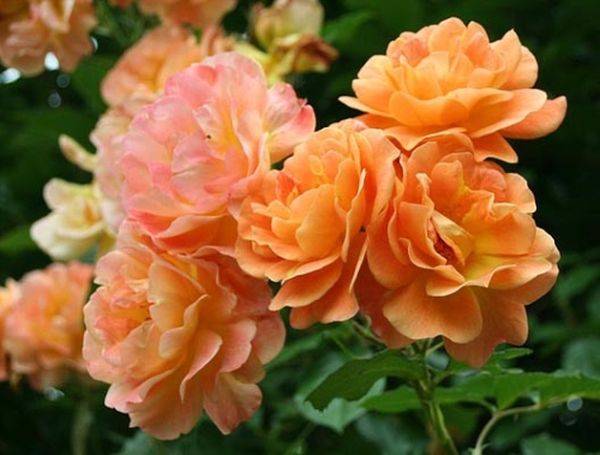

Lilies.
With lilies for the winter, there are two options: dig it up or leave it in the ground. If you do not want to bother with annual digging, the flower bed should be located in a place where it will be sunny in summer, in winter it will be well covered with snow, and in spring the flowers are not threatened with flooding by melt water. Otherwise, in the first year with little snow, the bulbs will freeze and the plant will either die immediately, or gradually crumble and stop blooming.
If you managed to find a good place for a flower bed, you can prepare lilies for wintering in the ground:
1. After the stem has dried out, carry the pruning, leaving 10 cm from the root.
2. Feed each bush with half a liter of a mixture of potassium salt and superphosphate (one teaspoon each), dissolved in hot water (let the water cool until lukewarm). Top dressing is done after flowering, so that the bulbs gain strength for the winter.
3. Insulate the flower bed by covering it with available materials. Seasoned gardeners recommend spruce branches for sheltering lilies, since the resin of conifers has the ability to scare off parasites.
4. There is a life hack for flower beds prone to flooding. To prevent the bulbs from rotting in the spring, during the melting of the snow, the flower bed is covered with a film, roofing felt or other waterproof material.
The second option is to dig. In the first half of September, the lilies are cut off, the bulbs are dug out with a pitchfork, washed in warm water and dried so that mold does not start on the top layer. You can dip in a weak solution of potassium permanganate. You need to store in a room where the temperature does not drop below 0 degrees. You can place the bulbs in a box of slightly damp sand, covered with damp gauze on top. From time to time it is worth checking whether the sand is dry or, on the contrary, whether rot has appeared.
Both options do not require much effort, but will greatly help your flowers survive the winter.
New dawn
This type of flower stands out from other hybrid varieties. In the process of breeding it, breeders used distant relatives of this culture from America. The result was a magnificent specimen, endowed with such qualities as frost resistance, high immunity to diseases and pests; flowers that are beautiful in appearance and have a sophisticated scent. The flowers of such winter-hardy plants are traditionally painted in pleasant pale orange and cream colors. At present, a special variety is known - the white rose, - the flowering of which the gardener will be able to observe only once a year. Therefore, when making a purchase of seedlings, it is recommended to clarify whether these crops are continuously blooming.
WHERE TO BUY FLORIBUNDA ROSE SEEDLINGS
The online store "BECKER" sells a variety of high quality planting material grown in nurseries in Russia, Poland, Holland and other countries.The assortment includes more than 2000 commodity items, among which there are the rarest varieties and crops. The goal of the company is to provide the buyer with a wide selection of elite planting material, from seeds to varietal seedlings. We give a guarantee for all planting material - 90 days. We are always in touch to support and advise you both on the varietal assortment and on planting and growing crops. An order can be placed either directly on the company's website, or by mail or by phone. returns 10% of the funds spent by the buyer on ordering planting material under the bonus program. Sending seedlings - this is what often stops buyers from buying seedlings from you, you do not need to worry about the safety of planting material during shipment - in order to protect the goods, the store uses a unique technology for packaging goods using a hydrogel. All seed and planting material is stored in our own warehouse and is always available, so there is no need to wait for it when ordering. We are waiting for you for shopping: Online store "BECKER"
William Shakespeare 2000
If you want to have in your flower garden one more rose that is the easiest to care for, at the same time resistant to low temperatures, and at the same time a beautiful culture, you should choose the William Shakespeare 2000 variety. This type of flower comes from England. It was invented by breeder David Austin specifically for beginner growers who do not yet have much practical experience in growing such plants.


This species does not actually require complex planting of seedlings, complex care. It has a number of advantages: resistance to cold weather, draft, wind and other climate difficulties. He received a stable immunity to major diseases. The bush growing on the site is able to reach 1 meter in height and have a large number of inflorescences on the branches. The gardener gets the opportunity to admire the velvety flowers. Initially, they are colored red, but over time they acquire a delicate purple hue.
How to carry out autumn pruning correctly
In order to achieve exactly the effect that autumn pruning is aimed at, it is necessary to do it as follows:
- when pruning, you need to use only sharp scissors or pruners - then the stems at the cut site will be less injured and heal faster, and this will help to avoid moisture and infection penetration there;
- the shoot should be cut off by about 1.5 - 2 cm above the already swollen, but not yet blooming bud;
- if the shoot is dry, it must be cut off until living tissue appears;
- the cut on the shoot must be done at an inclination of 45 degrees, this will also contribute to its rapid healing;
- roses should be pruned on a warm, dry, windless day.
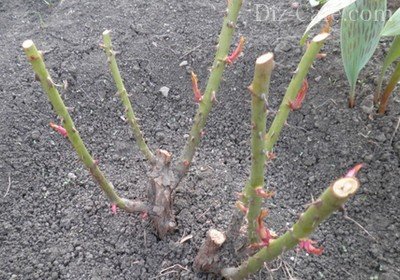

Usually roses are cut a week and a half before the shelter, around the end of October. But in cold regions, in particular in Siberia, the pruning time shifts a little, since early frosts can damage the plant. In Siberia, roses should be pruned before October 20th.
It should be borne in mind that any pruning stimulates the growth of the kidneys. And if you cut the rose too early, before the first light frost, then it will start to release fresh shoots, which will simply freeze later.
You need to start pruning your roses when the temperature at night is about minus 2-3 degrees. Then it's time to take on the secateurs.
You should not be especially zealous when pruning a rose. Keep in mind that the above-ground part of the plant should be roughly the same size as the underground one. And the roots of the rose are quite long. Therefore, it is not necessary to cut the shoots "at the root".
Short pruning is allowed only for those roses that are heavily overgrown and bush. The rest of the roses need medium pruning, in which the stems are shortened by about a third.
Golden Celebration
The fifth in the ranking of the most suitable species for giving, with the necessary characteristics, is Golden Celebration. These beautiful flowers also owe their appearance to the specialist David Austin. The culture is well suited for cultivation in the climate of the Moscow region. When carrying out simple care, the flowering of this beauty can be observed twice a year.
The flowers are usually rounded, rich in yellow, and have a caramelized aroma with a hint of lemon scent.
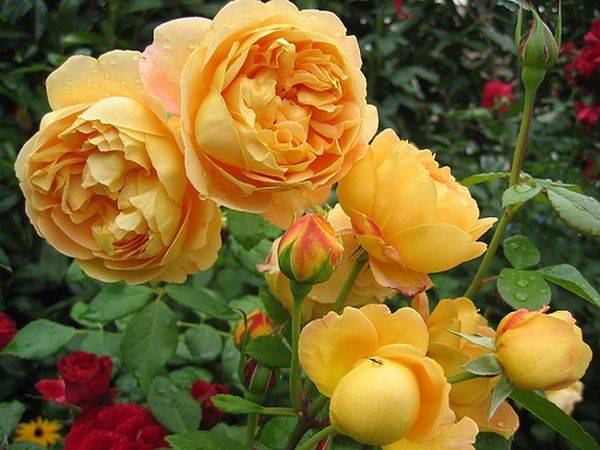

They appear on stems, the average length of each of which is about 60 cm. Such bushes grow and develop normally, regardless of the vagaries of the weather. They also practically do not get sick, which makes it easier for the grower to take care of his favorite plants, which is already easy.
grow-
Related Topics:
- ← Ficus robusta home care
- Rose floribunda niccolo paganini →
Add comment Cancel reply
This site uses Akismet to combat spam. Find out how your comment data is processed.
Related Videos
Frost-resistant roses


Roses in Siberia and Altai The most winter-hardy roses Canadian varieties Where to order and how to plant Frost-resistant roses. Canadian Roses: An Overview of X Varieties
When and how to take cover
In the spring, when everything in nature begins to thaw and come to life, roses must be removed from the insulating materials, otherwise the snow, which quickly turns into melt water, will contribute to the drying out of the root system. When using the frame method, you must first open the ends of the structure, then one side, then after a couple of days the entire structure is disassembled.
Removing the covering material should be carried out in calm weather, for 5-10 days the plants should be shaded to avoid sunburn.
Part of the covering material can be left for a while, this will be a kind of insurance against frost that may return. A step-by-step parsing will allow the plant to adapt to external weather conditions in a natural way. After a complete disassembly of the frame structure, you need to trim the shoots that have suffered during the winter. And after a while, carry out the first feeding.
Do not be intimidated by the cultivation of roses in Siberia. Subject to the rules for the preparation and shelter of the bushes, the wintering of the rose will be successful. The gardener's care for this wonderful flower will help it to survive, stay healthy, and in the summer fill the garden with a fragrant aroma.
Even a person who is alien to floriculture and is completely unaware of the intricacies of growing plants, stops his gaze on beautiful flower beds, front gardens, alpine hills. Tulips, violets, daffodils, dahlias - they all delight with their colors and unusual shapes.
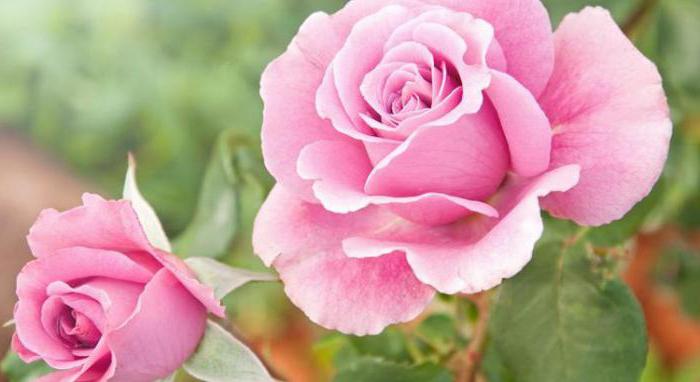

When to start cooking
Growing a strong and healthy plant is one of the main conditions for preparing roses for winter. Competent care and a number of measures will reliably preserve the plant.
It is important that the work is carried out systematically, because the summer in this area is very short, and the cold will not keep you waiting. All roses, regardless of their species differences, begin to prepare for wintering in the second half of summer.
With the onset of August, the plant is no longer fed with nitrogen compounds. This interferes with the process of growing green mass.
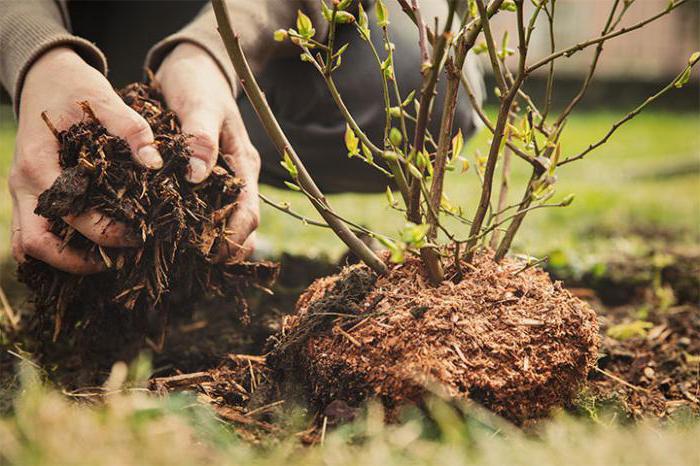

Already in September, they make the last dressing with phosphorus-potassium fertilizers. Gardeners most often use simple wood ash for this.
In order for the plant to have as much nutrients and strength as possible for growth, providing preparation for wintering, all new inflorescences and shoots are pinched.
Caring for roses in September in Siberia involves stopping watering. Such a measure does not allow the plant to go into a dormant period with an excess of moisture, which can cause frost damage.
When the shelter is taken away
We figured out how to cover roses for the winter in Siberia, but it is equally important to free the bushes from insulation in a timely manner so that they can go into the growth stage.It is important to observe the golden mean here, because if you hurry, then the roses can freeze, and, otherwise, begin to rip out.
It is recommended to open the bushes covered with insulating material when the soil has warmed up and thawed. Thus, the shoots will not suffer from excess moisture.
Roses covered with a frame-air method are opened gradually. They start from the side parts, then the north or east side, and after a couple of days, the insulation layers must be completely removed. Since the weather often changes in early spring, the shelter is not completely removed for some time. The gradual analysis of the design allows the plants to gradually adapt to the changed conditions.
Do not rush to leave the rose in the open sun. For cleaning the insulation, cloudy weather, without strong winds, is chosen. Then the bushes are protected from direct sunlight for another 7-10 days to avoid burns.
The final stage is pruning frozen shoots that are incapable of growth and feeding with nutrient mixtures.
If all the rules have been followed, then you can safely expect a flowering period.
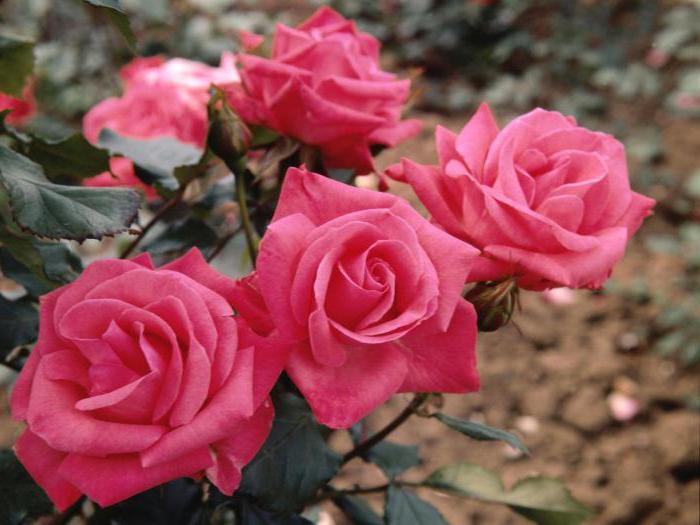

This article helped to find out the details of how to cover and prune roses for the winter so that they can withstand even the harsh Siberian frosts. By following these tips, you can create a beautiful rose garden despite difficult weather conditions. Let Siberia pamper with warmth for a very short time, but even in this short time you can please yourself and your loved ones with live roses.
Not only people and animals need warmth. Plants can only protect themselves at certain temperatures, but sometimes they need the help of a gardener who knows how to protect them from the cold. If you take good care of it in a timely manner, the roses will surely be rewarded with abundant flowering, and the garden will turn into a fabulous corner.
Those gardeners who have been growing roses for a long time will never forget to prune their plants in autumn. And this is not surprising - it is thanks to the correct pruning of roses in the fall that a healthy and beautiful bush is formed, which next year will delight you with luxurious fragrant flowers.


Therefore, it is imperative to prune your rose bushes in the fall.
In the spring, pruning a rose, we simply form neat bushes. IN
Spring pruning is more decorative and not mandatory. By removing excess shoots in autumn, we rejuvenate the plant, extend its life, stimulate the development of new shoots, and strengthen the root system.
And the correct shelter of the rose for the winter is just as important. This procedure is especially important for roses that grow in Siberia, given the early frosts and cold snowy winters of this region of our country.
However, with proper pruning and timely shelter, roses in Siberia are in no way inferior in beauty and decorativeness to their southern relatives, and in the same way they delight the eye.
Roses and Siberian climate
The climate in Siberia is characterized by cold winters, a lot of snow and late spring. During the year, there are large temperature drops: extremely low in winter (up to -40 ... -60 ° C), in summer - high. The transition from winter to summer occurs quickly, there is no off-season.
For garden roses, Siberia is considered a high-risk area. So that roses not only grow well, but also bloom in such conditions, the following requirements are imposed on the varieties:
- high frost resistance of buds and wood;
- resistance to damage by fungal diseases;
- the ability of wood to quickly ripen;
- the ability to well restore vegetative mass;
- the possibility of early flowering.
During the summer period, there is a lot of sunshine in this climatic zone, so no special conditions regarding shade tolerance are required. The best shelter from the winter cold is snow. It protects the roots and the ground part from freezing.
Wintering of roses in Siberia at an air temperature of -25 ° C is quite comfortable, because the snow temperature is only -2 ... -3 ° C. When preparing plants for wintering, one must not forget that under a thick layer of snow, roses are in another danger.
Under the thickness of organic matter, plants are waterlogged and die. Preparations for the winter period begin in August. To slow down growth, watering is stopped, nitrogen fertilizers are not used for feeding.
The introduction of potassium-phosphorus fertilizers helps to strengthen the root system, increases resistance to the influence of adverse weather factors.
In autumn, roses are stopped to loosen near the bushes so that young shoots do not begin to grow. Pruning is required for wintering (it is not needed for climbing and park varieties). Cut out all the greens, including young shoots and leaves (they will not withstand frost).
Remove debris from under the bushes to prevent fungal diseases. Roses are treated with Bordeaux liquid to increase protective forces and resistance to moisture.
In order for the root system to receive more air, which will protect against frost, after spraying, the bushes are sprinkled (the ground is raised to 20 cm). After the procedures are completed, you can wait for the onset of stable cold weather.
There are frost-resistant (frost-resistant) roses for Siberia, which, under a layer of snow, are able to winter without additional shelter.
A little about rose bushes
Before planting these flowers, it is necessary to familiarize yourself with the recommendations of specialists about the care and carry out some preparatory work. Gardeners living in Siberia must select information adjusted for their region. Optimal conditions for keeping roses: temperature in the range of 22-27 ° C, average humidity and direct sunlight. You can plant bushes in places with a predominance of diffused light, but the color of the buds will be pale, and they themselves gradually grind.
Despite the apparent strength of the stems, it is not worth planting on areas of the terrain, which are characterized by piercing winds - icing and death of flowers is possible. When drafts walk through the garden, the seedlings are placed near the walls of houses or decorative pavilions.
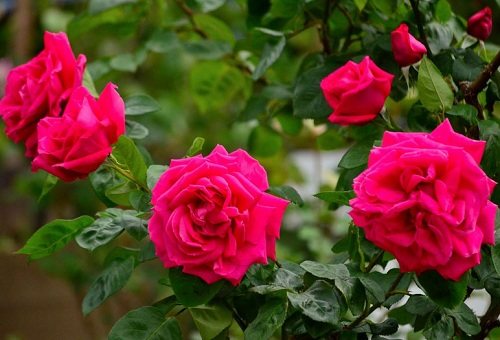

Proper care begins already at the stage of soil selection in the spring. The soil for roses should be loose, nutritious, with neutral PH values. Even the climatic conditions of Siberia are suitable for planting bushes on slightly acidic loamy soils without stagnant moisture. With constant flooding of flower beds with groundwater, even such moisture-loving plants can be lost - putrefactive processes will occur.
Advice: to avoid decay, experts advise - to properly dig holes for seedlings at least a couple of weeks before planting. If during this time it is filled with water, then you can transfer the future flower bed to a drier area or lay a thick layer of drainage material in the pit.
When they also wanted to plant roses in Siberia, agronomists began to plant ordinary rose hips on the bushes. The result is a unique frost-resistant species. They are characterized by fast rooting in spring, which is important for short summers and autumn. Some of the rose varieties do not require wintering in cellars.


Roses can be planted in autumn and spring. In mid-November, the time is chosen so that, before the onset of frost, rooting occurs, but the buds do not begin to swell. The flower will spend all its energy to form leaves, not roots, and may die in winter. In the spring, planting is carried out when a positive soil temperature (8-11 ° C) is established. The first to properly plant grafted, frost-resistant seedlings, roses with their own roots a week later. For Siberia, planting of ornamental bushes is possible from mid-May.
Climbers
These are, one might say, monumental climbing roses. Planting and caring for this variety in Siberia can be complicated by difficulties with shelter. Compared to ramblers, whose whips reach five meters in length, climbers are just babies. Their shoots do not outgrow the 2-meter mark.However, they are very thick and do not bend as easily as miniature ramblers. It is very difficult to wrap such an escape around a post or arch. If you run the branch vertically upwards, then it will bloom only at the upper end. Flowers are very abundant when the branch is horizontal. In a flower garden, they are placed in a fan on fences, trellises. This stimulates the regrowth of new flowering shoots. If you want the roses to bloom as long as possible, then stop feeding with the bud setting, and water daily in dry weather. And climbers bloom luxuriously! Large fragrant flowers adorn the bush for almost a month, and for remontants, twice a season. The best varieties are Elf, Rosanna, Pink Cloud and Pierre de Ronsard.
Powdery mildew
The disease often affects roses growing in a greenhouse. In climbing roses, it occurs as a result of damping as a result of too much watering in cool weather. It affects the young parts. They are covered with a white powdery coating. Spraying the bushes with wood ash infusion is very effective in this case. First, you need to remove the affected leaves, buds and shoots, cutting them to healthy tissue. All this must be burned so that the pathogenic microflora does not resume activity. The cleaned bushes should be sprayed with an ash solution, and after two hours, rinse it off with clean water. In case of severe damage, drugs containing triazole are used - "Skor" and "Topaz".
Greenhouse construction made of polyethylene
You can use polyethylene to close the plant securely (you can first cover it with roofing felt, bituminous paper, cardboard). The shelter protects from the cold and with properly organized ventilation, the bushes will comfortably survive the winter.
To create a shelter, you will need:
- rods or arcs made of metal;
- roofing material;
- polyethylene film.
The sequence of creating a shelter:
- perform preparation (the plants are pruned, fertilized, tied and laid on the ground);
- arcs of a metal bar are installed over the bush in order to further stretch polyethylene over them;
- after the onset of cold weather, the arcs are covered with roofing material, then with polyethylene.
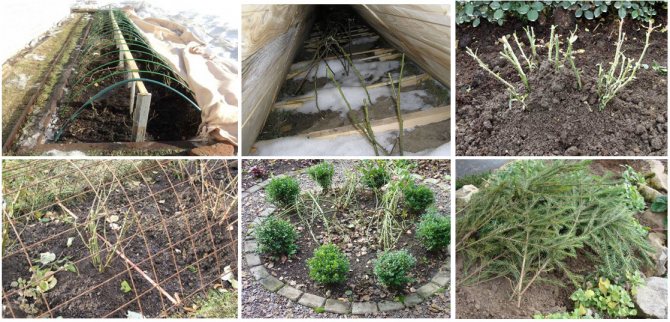

Preparing and covering roses for the winter.
Moisture does not accumulate under such a shelter. If you raise the edges of the roofing material, fresh air will flow to the plants.
Sometimes, when creating an air-dry shelter, one of the edges of the film is left raised. But with this approach, there is a risk of freezing the plant. It is recommended to use a thin tube for ventilation that runs along the ground from the inside of the shelter to the outside.
Some gardeners, after hilling the bushes, build a hut of bars or boards over them. Then they are covered with a thick plastic wrap, which reliably protects from precipitation and wind. The soil is always dry inside, and the shoots are well preserved until the onset of spring.
Is cropping necessary
This is not to say that this procedure is mandatory, but in most cases it is still necessary. The stem bush is buried in soil for the winter, so it is recommended to get rid of excessively long shoots so that the shelter is compact and convenient.
Climbing roses deserve special attention. In Siberia, the cultivation of this species has its own subtleties. If more than 10-12 branches have formed, remove those of them that are older than three years. Weak and poorly developed shoots are also removed.
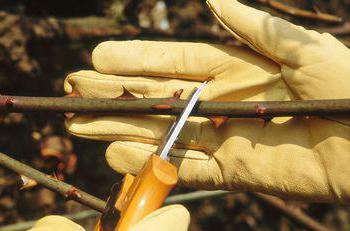

In vigorous varieties, the stems are long, so they are shortened so that the strong wind does not harm them.
If you find places on the bush that have been affected by any diseases or pests, you should cut them off. The removed branches are burned to prevent further spread of diseases.
However, some gardeners are of the opinion about the harmful effects of cutting off shoots. In their opinion, after removing the branches, wounds may appear where the infection gets. Because of her, the bushes are much more difficult to adapt to cold weather.
Before covering roses for the winter in Siberia, foliage is removed from them.This must be done carefully, holding the trunk with your hand so as not to damage the bark of the shoot. Only faded flowers are left. When fruits begin to form from them, the plant plunges into a state of dormancy, and the wood ripens.
Suitable varieties
Those who, nevertheless, were not frightened by the Siberian frost, may well grow a wonderful rose garden. For efforts to be crowned with success, you should select those plant varieties that can tolerate such a climate.


• New Dawn, Rosarium Utersen - climbing varieties;
• Cinderella, Red Eden Rose - shrubs;
• Burgundy - hybrid tea species;
• Ice Meidiland, Bonica - ground cover roses;
• Lions Rose, Aspirin - floribundas;
• Harkness, Austinok - varieties that are able to survive in difficult weather conditions, but they are very demanding to care for, so they are more suitable for experienced florists.
Variety with fragrant flowers
Musk roses are highly appreciated by many gardeners. Planting and caring for this variety in Siberia will be successful if you choose a place for them with loose neutral soil, well protected from cold winds and sufficiently illuminated. Traditional musk roses exude a strong amber scent. It does not come from the petals, as is the case with other varieties, but from the stamens, so even withered flowers continue to smell. However, they do not always have such a bright aroma. Many hybrids are more decorative than older varieties, but odorless. Musk roses produce flexible whips up to 2.5 meters long. This allows them to be used to decorate gazebos and arches. The best varieties are Mozart and Ballerina.
Planting recommendations
In order for frost-resistant roses for Siberia to endure the cold well, you need to know a few useful secrets:
• It is better if the soil is slightly acidic and contains a lot of humus.
• The pit in which the rose is placed is recommended to be prepared in advance, in the fall, and in the spring it is good to water it with water.
• Before planting, a small slide is made in it, consisting of soil and nutrients. On top of it, the roots of the rose are neatly laid out. Especially long ones need to be shortened.
• The paraffin that protects the aboveground part of the plant is removed, and the seedling is covered with earth so that the root collar of the bush is 6-7 cm below the soil level.
• If the rose belongs to climbing varieties, then the deepening must be increased to 12-16 cm.
• Frost-resistant species are covered less thoroughly before wintering.
• Fluff the plant up to about 12 cm so that the moisture evaporates more slowly.
How to care for a flowering bush?
Caring for roses always means abundant watering. For proper watering, several buckets of water are required per bush 2-3 times a week. If you apply water under the root every day, then you can overmoisten the root system. The result will be the formation of various putrefactive processes and the plant will die. When the heat is stable, you need to water every day - drying out of the roots is unacceptable.
Bushes need constant pruning. When unnecessary young shoots are cut, the plant spends energy on the formation of buds. Cardinal pruning is required for a flower before planting in flower beds. Cut off shoots by two-thirds of the length of the stems. Young shoots will grow stronger and give a stronger flowering with this kind of care.
Advice: experts warn that climbing roses cannot be cut after wintering. Large and bright flowers are formed on overwintered shoots.
Ornamental bushes are highly respected in the care of the use of both organic and mineral fertilizers. Fresh manure cannot be used, since there is a high probability of burning the root system. But rotted half-year (especially horse) is perfect.


When to fertilize:
- For a more lush flowering during the budding period, the bushes are fed with calcium nitrate (25 g per bucket of water).
- Complex mineral fertilizers and a weak organic solution are applied twice a month under the roots of roses.
Even with proper care, brown or black spots can form on the leaves, which then spread to the entire plant. All damaged parts of the bush should be cut off and treated with any insecticidal preparation. The most dangerous disease for a flower is powdery mildew. Usually occurs on purchased seedlings when the plant was initially infected. The main symptom is whitened drying leaves. Too damaged bushes must be burned, the remaining ones should be sprayed with insecticide.
Roses can be grown in all climates. In Siberia, gardeners plant as many varieties on flower beds as in any other region. The main difference is the need to shelter the bushes from severe frosts with the help of wooden frames, peat and spruce branches. With further care, you should act according to the general rules with minor amendments to the place of residence.
Contemplating rose bushes is extremely rewarding. Just a short walk through the blooming garden in spring calms, worries and worries recede. Fragrant inflorescences are used to make sachets, and amazing jam is prepared from the mistress's petals. And you should delight yourself and loved ones with lush bouquets throughout the summer.
The nuances of growing outdoors
For a long time, Siberian flower growers did not dare to cultivate thermophilic crops in the garden, but with the advent of frost-resistant varieties, they began to try to plant roses in an open area. Many have succeeded.
Landing dates
In order for the flower to begin in the climate of Siberia, which is characterized by a late spring, and frosts begin early, it is necessary to plant a climbing rose when the earth warms up well, dandelions bloom. And this usually occurs not earlier than the end of May.
In the fall, it is recommended to send adult bushes to an open area, which manage to take root before the arrival of winter weather.


Location selection
It is also possible to create comfortable conditions for a rose in a climate where summer is short and the sun does not rise as high above the horizon as in the south. When choosing a place for a plant, you need to take into account some of the nuances:
- A rose should not be planted in a lowland, where the soil deeply freezes in winter.
- It is better to place the culture not in the sun, but in a light partial shade.
- The area for the flower should be protected from cold winds blowing from the north or east.
Buildings are decorated with climbing varieties, but so that the plant does not ice up and die, they plant it at least a meter from the wall. The rose does not tolerate stagnant water, looks harmonious, feels good next to conifers and shrubs, irises and clematis.


Preparation of planting material
You need to buy a rose at a local nursery, where varieties adapted to natural conditions are sold. It is necessary to choose a seedling for growing with strong roots and shoots, with a green stem. To make the rose take on a new place faster, move away from the resulting stress:
- Potassium permanganate powder is poured into the water, the roots are placed in the prepared solution for a day.
- The flower is soaked in the "Zircon" growth stimulator.
- The shoots of the plant are shortened by 20 cm, damaged branches, dried root areas are removed.
Shortly before planting, the sections are wiped with "Fundazol". Roses, which are sold in a pack with a lump of soil, are placed in the soil along with a container made from a material that dissolves in the ground.
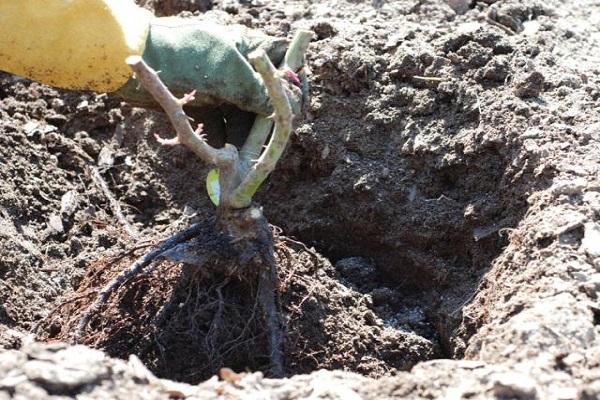

Landing rules
The site for the climbing rose is dug up, leveled, removed from the roots of the weeds. Acid soil is diluted with ash or dolomite flour, a pit for a seedling is made up to 0.8 m deep:
- A thick layer of fine gravel or expanded clay is poured onto the bottom, river sand is added on top.
- Connect humus, peat and garden soil.
- The well is filled with a nutrient mixture by a third, put 2-3 tablespoons of superphosphate and one potassium salt.
- The rose is placed vertically in a hole, the roots are straightened and buried below the surface by 10 centimeters.
- Supporting the bush with your hand, cover the space.
The seedling is irrigated with warm water.Around the plant, the earth is compacted, a small shaft is built. For the first 2 weeks, a young rose is covered from the sun's rays.
Methods of protection against diseases and pests
Lack of sunny color, deficiency or excess of moisture, lack of nutritional components provoke a weakening of climbing roses. Plants are affected:
- peronosporosis;
- powdery mildew;
- black spot.
For the prevention of diseases in wet weather, the bushes are recommended to be sprayed every week with the drug "Fundazol". To prevent infection by fungi, every 10 or 14 days the leaves and shoots of the rose are treated with the fungicides "Zircon", "Fitosporin".
The flowering plant is strewn with microscopic aphids. If spraying with a solution of tobacco dust and laundry soap did not help to cope with insects, the home remedy is replaced with chemical insecticides in the form of Aktara, Karbofos, Aktellik.


Planting and caring for roses in Siberia
The beauty of Siberia is called harsh. Its wide, immense forests, mighty rivers, white snow blankets create a unique feeling of the power of nature, which has painted the earth in blue-green tones. All the more magical against this background are the delicate and beautiful rose flowers of almost all colors of the rainbow, capable of falling in love with gardeners of any area.
Growing roses in Siberia is a more laborious task than in the south, but the reward for it is also higher - it is delight from the contemplation of the “queen of the garden” bloom, pride in your skill and “light hand” of the gardener, and admiration in the eyes of friends.
Selecting and preparing a landing site
Any kind of rose, even the most patient to weather conditions, requires a competent selection of a place when planting.
When planning the location of the rose bush on the site, preference should be given to the place, the maximum time during the day, illuminated by the sun. If possible, protection from cold northerly winds should be provided; a good location will be the location of the plant on the south side of any buildings, or low trees, shrubs that create wind protection, but do not shade the planting.
The rose is able to grow on almost any soil, except for those with a strongly acidic reaction, sandy and heavy clay, but prefers light, well-fertilized, slightly acidic. At the same time, the plant is sensitive to the height of groundwater and swampiness, in such conditions roses do not take root well, get sick, and hibernate badly.
In areas where the groundwater level is less than 1 meter, the terrain is flooded in spring or autumn, a good solution is to plant roses in raised ridges. Such a planting will protect the roots of the shrub from damping out and decay, and will provide a faster heating of the soil in spring and slightly extend the short Siberian summer.
For spring planting, it is better to prepare a pit in advance, even in the fall. The size of the pit depends on the size of the root system of the plant, on average 50x50x50 cm.Since under favorable conditions many varieties of roses grow in one place for more than 25 years, it is better to fill the hole with nutritious soil, as well as planting fruit trees, providing the plant with a margin of safety. At the bottom of the planting pit, a mixture of the top layer of soil (humus), ready-made compost, rotted manure, sand, wood ash is laid.

